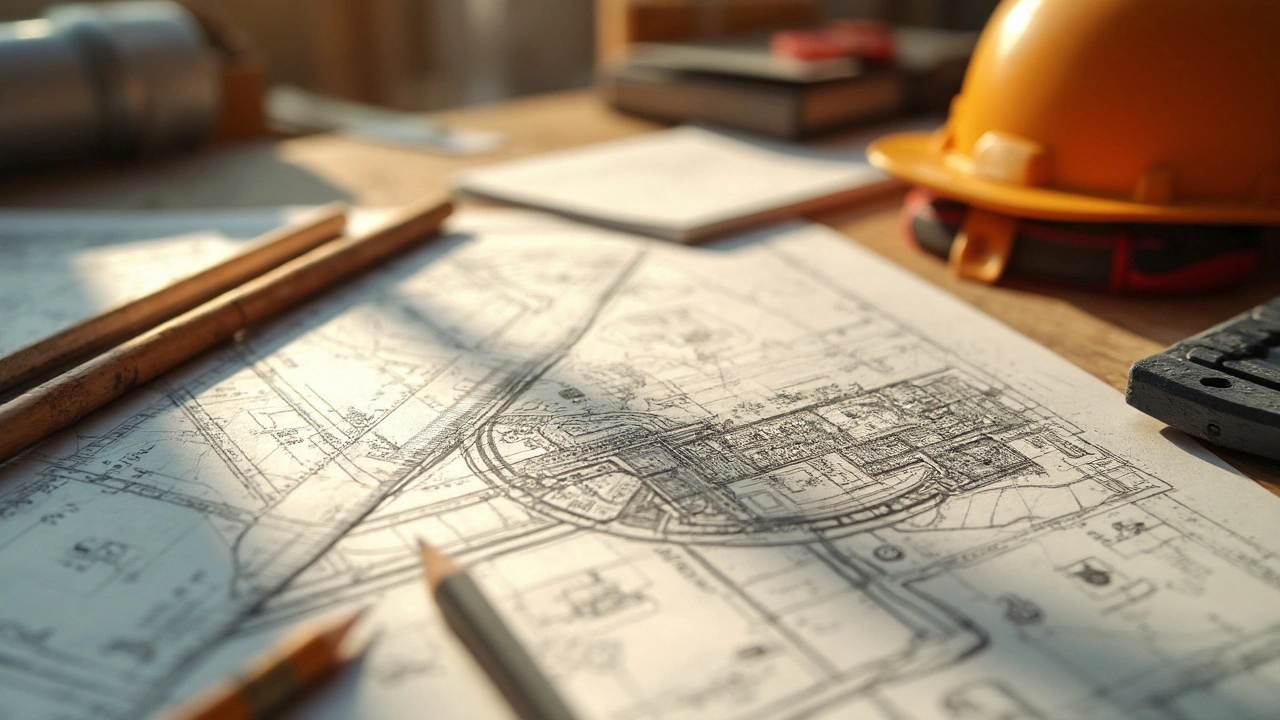Loft Conversion Disadvantages: What to Know Before You Start

So, you're eyeing that dusty attic and dreaming of transforming it into an awesome loft space, right? Hold on a second. Before you get too carried away with Pinterest boards and mood lighting, there are a few bumps on this dreamy path you might not see coming.
First up, let's talk space limitations. Sure, that area seems like a goldmine of potential, but in reality, lofts have quirks. Ceilings are often sloped, making it a bit awkward to stand tall in some spots. Ever tried getting a decent wardrobe up there? Yeah, it’s like playing a game of Tetris. This means your design dreams might face a squeeze.
And then there’s the structural side of things. Your house wasn’t originally designed for people to wander around up top. So, making sure your new loft doesn’t start sagging is critical. You might have to bring in an engineer to beef things up, which, spoiler alert, is going to cost you.
Speaking of costs, this isn’t a project where you can just wing it. Setting a budget is crucial, and even then, unexpected expenses have a habit of popping up like uninvited guests. New staircases, extra insulation, and skylights add up faster than you think.
- Space Limitations
- Structural Challenges
- Cost Considerations
- Planning Permission
- Impact on Home Value
Space Limitations
Looking at your attic, it might seem like a treasure chest of unused potential just waiting for a loft conversion. But the reality can be a bit more cramped than you'd like. One of the first hurdles people hit is dealing with sloped ceilings, which eat into precious headroom. Imagine standing up only to be greeted by a low ceiling there to remind you that this wasn’t designed for living in the first place!
Take, for example, older homes where those beautiful yet pesky beams often run right through potential loft space. They aren’t just decorative; those beams are holding up your roof! Navigating around these obstructions while trying to keep a smooth flow isn’t just tricky; it’s almost an art.
Now, think about furniture. Bringing bulky items like wardrobes, or even fitting a bed, can turn into a logistical puzzle. You might need to opt for custom pieces, which could squeeze your budget even further.
Also, keep in mind that building regulations might require you to add insulation, which will further encroach your space. A fully insulated loft might not give you as much room as you initially thought.
- Sloped ceilings: Restricts movement and usable wall space.
- Structural beams: Can obstruct floor plans and design ideas.
- Furniture fitting: Standard furniture may not fit, requiring custom solutions.
- Insulation demands: More insulation may mean less open space.
These constraints mean you need a bit of creativity and perhaps expert advice to plan a home renovation that truly feels open and inviting. Before you dive into the renovation, being clear about what you can realistically achieve in your space can save both time and money.
Structural Challenges
Tackling a loft conversion isn’t just about beautifying your space; it’s about making sure your house keeps standing as it should. The major hurdle here is that existing floor structures weren’t typically designed to double as living spaces.
When you're converting that loft, you’re adding more weight than usual to the floor, which can lead to the whole setup flexing or, worse, cracking. Enter the structural engineer. Their job? To assess whether reinforcements are needed—often, they are—and to design solutions that keep everything sturdy.
“Evaluate your loft conversion with a professional to prevent future structural issues,” advises Jane Smith, a well-known home renovation expert.
Without reinforcing those beams, worst-case scenarios include sagging ceilings downstairs or creaking floorboards, neither of which make for a happy home life.
One crucial bit is the placement of new load-bearing walls or beams to support the added weight. This might require bolstering the foundation or inserting steel beams. While they’re not the most glamorous aspect of home improvement, they are a must for safety and stability.
But hold on; there’s more. Ventilation comes into play since loft spaces can become energy traps, either too hot or cold, making it crucial to factor in effective ventilation options and adequate insulation.
Finally, always remember, structural changes equal more paperwork. It might be a good time to familiarize yourself with local building codes to ensure compliance, because if things go wrong, dealing with a failed inspection can be a real headache.

Cost Considerations
Alright, let's get into the nitty-gritty of how much a loft conversion could set you back. Spoiler: it's not exactly pocket change. On average, you're looking at anywhere from $20,000 to $50,000. But remember, like all home renovations, this number can shoot up quicker than you'd like depending on your choices and the surprises along the way.
One of the first things to think about is the type of conversion you're after. A basic room might be on the low end, while a fully kitted bathroom suite will kick things up a notch on the budget scale. Then there’s the structural stuff—reinforcing floors or installing steel beams sometimes isn’t optional, and it adds real bucks to your tab.
And don’t forget about the little things that can sneak up on you. Stairs for access, extra insulation, nice windows, even the basic stuff can quietly add up. If you’re in an older house, be ready for the quirks, like unexpected rewiring or plumbing challenges that your contractor uncovers.
If you’re savvy, managing your budget means planning ahead. Create a spreadsheet, keep tabs on expenses, and build in some cushion for surprises. An extra 10-15% over your initial budget is smart. Oh, and get a few quotes from contractors. Prices can vary a lot based on location and who you hire.
Let's also consider this—what about planning permission? Depending on your home's location and the scale of your project, you might need to get the okay from the council. This can mean extra fees and a wait, so factor that into your timeline and costs.
On the bright side, a well-planned and executed loft conversion can up your home’s value significantly, sometimes by as much as 20%! Just make sure you’re putting that money into smart upgrades that buyers (and you) will love.
Here's a quick snapshot of what costs could look like:
| Item | Average Cost |
|---|---|
| Basic Room Conversion | $20,000 |
| Bedroom En-suite | $35,000 |
| Structural Adjustments | $5,000 - $10,000 |
| Planning Permission | $500 - $1,500 |
Planning Permission
Jumping into a loft conversion without checking the planning permission scene is like diving into a pool without knowing its depth. Sure, some loft transformations might slip under the radar without needing permission, but don’t bet on it.
In the UK, for instance, loft conversions fall under 'permitted development' as long as you stick to certain rules. However, there’s a catch. If your property is listed or in a conservation area, you'll likely need to go through the full planning permission process.
Getting this sorted can be bureaucratic and time-consuming. It usually involves submitting detailed plans to your local council and potentially waiting weeks for a decision. Be prepared for a back-and-forth exchange if they have questions or need adjustments in your plans.
Here's a basic checklist of things that might require planning permission even if you think you’re in the clear:
- Extending the roof beyond the current height.
- Adding balconies or raised platforms.
- Chopping down chimneys that are iconic, affecting the overall look or structural balance.
Also, neighbors have a voice too. If they object to, say, new windows infringing on their privacy, this can complicate things. Maintaining good communication with them can help smooth potential hiccups down the road.
Remember, diving into costs for plans and permissions is an upfront investment. Getting denied can feel like burning money, so researching and sometimes hiring a planning consultant who knows the local rules can actually save you cash and headaches later on.

Impact on Home Value
Alright, so you’re all set to roll up your sleeves and dive into this loft conversion. But let’s pause and talk money, specifically how this conversion might mess with your home’s value. Spoiler alert: It’s not always a straight win.
Here’s the deal: a neatly done loft can make your house more attractive to buyers, especially if extra bedrooms are rare in your area. Some folks estimate these projects can boost home values by up to 20%! That’s a solid upside you might want to consider.
But, there’s a catch! If your neighborhood is chock-full of houses with similar lofts, or if your home suddenly becomes the most expensive on the block, you might not see that expected jump in value. Buyers might not wanna fork out extra cash if an equivalent house down the street costs way less.
Potential resale value isn’t just about adding space. It’s about making sure the loft feels like a natural part of the house. A mismatched or poorly planned loft could do the opposite, lowering your home's appeal.
One pro tip: Chat with a local real estate expert before dismantling your attic. They can give you the rundown on your area’s housing market and whether a home renovation like this usually nets a good return.
Bottom line? While lofts bring great perks, they’re not a magic wand for home value. Do your homework, know your local market, and make sure any changes match your home’s character.
Write a comment